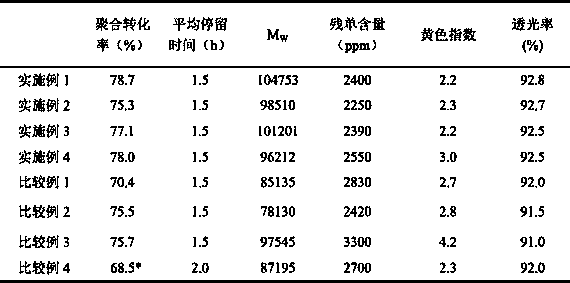Method for continuously preparing optical-grade polymethyl methacrylate
A technology of polymethyl methacrylate and acrylates, which is applied in the field of continuous preparation of optical-grade polymethyl methacrylate, can solve the problems of high proportion of solvent, damage to polymer thermal degradation resistance, and large energy consumption. Achieve high polymerization conversion effect
- Summary
- Abstract
- Description
- Claims
- Application Information
AI Technical Summary
Problems solved by technology
Method used
Image
Examples
Embodiment 1
[0023] Add initiator tert-butyl peroxide and chain transfer agent tert-dodecyl mercaptan to the mixture of methyl methacrylate and methyl acrylate, and mix the above raw materials in proportion. Mixture feed composition: based on 100 parts (mass) of monomer mixture, 97 parts of methyl methacrylate, 3 parts of methyl acrylate, 0.005 parts of tert-butyl peroxide and 0.2 parts of tert-dodecyl mercaptan . Charge nitrogen into the monomer mixture, remove the mixed oxygen, and control the oxygen content therein at 2 ppm. The mixed solution of the above raw materials was continuously added to the circulating tubular reactor replaced by nitrogen with a pump. The material circulates in the reactor through the circulation pump, and the ratio of the material circulation rate to the feed rate is controlled at 80:1. The temperature in the circulating tubular reactor was maintained at 150°C. Until the polymerization conversion rate reaches 59.5%, the polymerization mixture is transported...
Embodiment 2
[0025] The same method as in Example 1 was used. In addition to the composition of the mixed solution: 95 parts of methyl methacrylate, 5 parts of methyl acrylate, the ratio of the material circulation rate to the feed rate is 90:1, and the absolute pressure of the four exhaust ports is sequentially controlled to 120KPa, 50KPa, 15KPa and 4KPa, other conditions are identical with embodiment 1. After the reaction is complete, the polymer mixture is sent to a vented extruder for devolatilization. The polymer test results are listed in Table 1.
Embodiment 3
[0027] The same method as in Example 1 was used. In addition to the composition of the mixed solution: 97 parts of methyl methacrylate, 3 parts of ethyl acrylate, the temperature of the circulating tubular reactor is 145 °C, the ratio of material circulation rate to feed rate is 50:1, and four exhaust ports The absolute pressure is controlled to be 130KPa, 60KPa, 10KPa and 5KPa successively, and other conditions are identical with embodiment 1. After the reaction is complete, the polymer mixture is sent to a vented extruder for devolatilization. The polymer test results are listed in Table 1.
PUM
 Login to View More
Login to View More Abstract
Description
Claims
Application Information
 Login to View More
Login to View More - R&D
- Intellectual Property
- Life Sciences
- Materials
- Tech Scout
- Unparalleled Data Quality
- Higher Quality Content
- 60% Fewer Hallucinations
Browse by: Latest US Patents, China's latest patents, Technical Efficacy Thesaurus, Application Domain, Technology Topic, Popular Technical Reports.
© 2025 PatSnap. All rights reserved.Legal|Privacy policy|Modern Slavery Act Transparency Statement|Sitemap|About US| Contact US: help@patsnap.com

